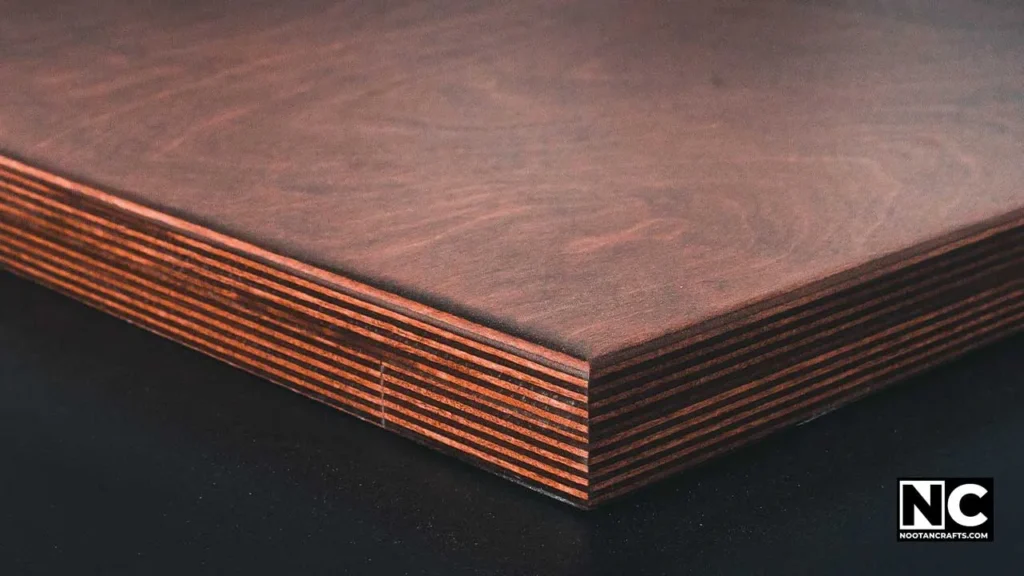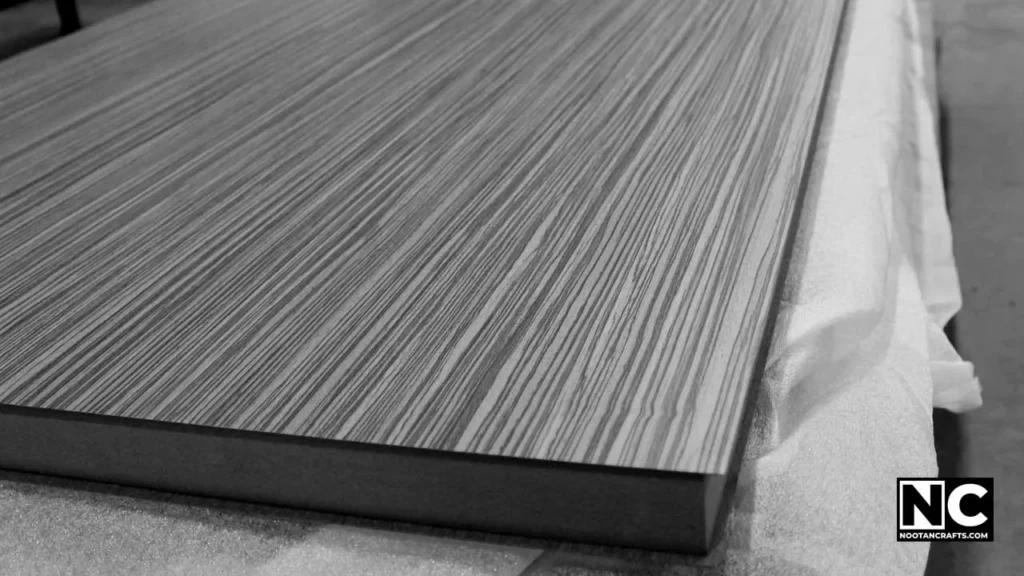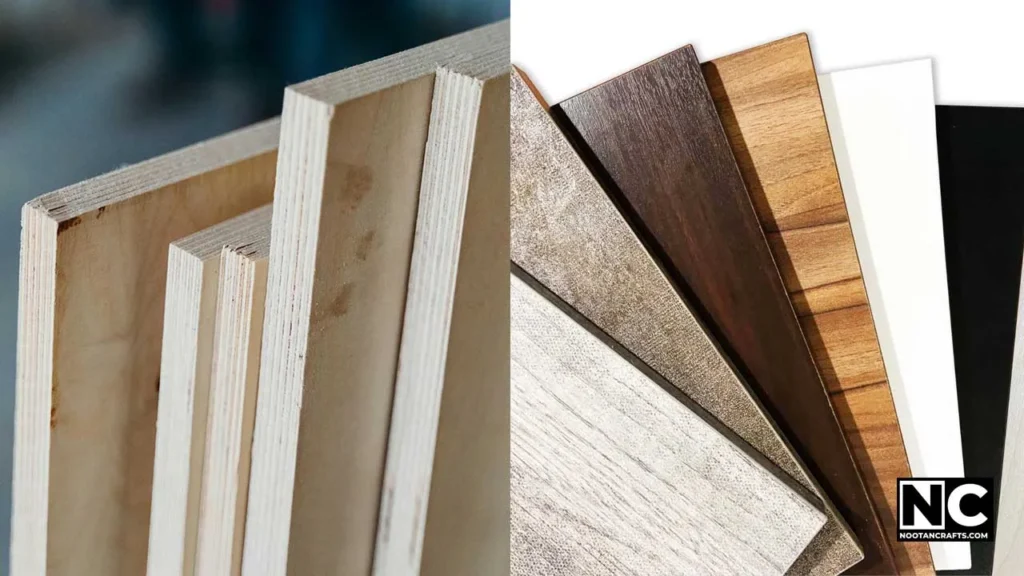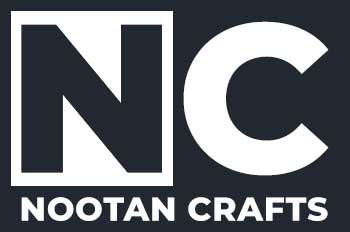Plywood vs Melamine: Which Material is Best for Your Next Project? I know it feels like a big decision, especially for DIYers like us who want to balance cost, appearance, and durability.
Both melamine and plywood have their strong points, but which are useful for your project will influence your ultimate decision. Whether you’re working on a kitchen renovation or crafting something for your living room, it’s essential to know the weaknesses and strengths of both materials before making your decision because it can make all the difference.
But how will you decide? Well, that’s exactly what we’re going to discuss in this post; by the end of this post, you will have a clear idea of which material is the best for your next DIY masterpiece — plywood or melamine. So, let’s do this!
What is Plywood?

Ah, Plywood! It’s a go to material for many of use who have spend time in the workshop. But how it’s made and what are its properties?
Playwood is made of glueing multiple thin layers of vaneer, which make it super strong. The secret a behind its sturdiness lies in its layer’s arrangement, each vaneer placed in such as way their grains run perpendicular to each other. The cross-graning structure make a playwood less prone to warp or crack.
You will encounter different types of plywood in the market, but there are mainly two types — structural and non-structural plywood. In short, if you’re making a project which involves load-bearing structure and may come into contat with harsh elements, the structural playwood is recommended. On the other hand, for all indoor need and DIY projects, non-sctructural plywood is used. The non-structural plywoods are specially designed for decorative and interior use and they are a bit cost-efficient.
You might be worndering, Nootan what about the other plywood types that I have heard — like hardwood, softwood, marine, and tropical? As I already told you the main types which are structural and non-structural – each plywood types falls under these.
Structural Plywood:
- Softwood Plywood (Durable and strong, commonly used in construction).
- Marine Plywood (Waterproof and strong, ideal for boats and outdoor use).
- Laminated Veneer Lumber (LVL) (High-strength beams and framing material).
- Fire-retardant Plywood (Treated to resist fire for safer construction).
- Hardwood Plywood (Smooth finish, used for furniture and cabinetry).
- Tropical Plywood (Mixed hardwoods, often used in decorative furniture).
- Moisture-resistant (MR) Plywood (Resists moisture and is used indoors for light-duty furniture).
- Flexible Plywood (Bendable, used for curved furniture and decorative designs).
Now, let’s talk about melamine. Is it any better than plywood?
What is Melamine?

Melamine technically isn’t wood, rather its a type of laminate made from thermally-fuse platic material. It’s often blended with MDF (medium-density fiberboard) or particleboard to create a smooth surface.
Melamine is widely used in the modern sleek furnutire such as kitchen cabinets, it’s affordable and easy to clean. The best thing about it, it can be easily cleaned with a damp cloth and its scratch-resistant as well.
On the flip side, melamine is not the most durable material, especially as compared to plywood. It’s a great choice for making shelves or low-impact furniture, but it can’t handle the same torture as plywood. Also, if it chipped or heavily scratched (nothing’s invincible) it’s a tough for repair. Moreover, you can’t sand it down or refinish it like you would plywood.
Plywood vs Melamine: Key Differences

Now, let’s talk about the real stuff: How do plywood and melamine compete with each other?
Durability: Plywood is the clear winner here. It’s much stronger and can deal with more wear and tear. Melamine, on the other hand, is more prone to chipping and can’t really take heavy stress.
Cost: Undoubtedly, melamine is the cheaper option. If you’re on a tight budget and working on a project where appearance is preferred over durabiliy, melamine could be a good option.
Appearance: This one’s a bit tricky because it depends on the taste. Plywood offers that natural wood look that can be customized with stain or paint to match the theme. In contrast, melamine offers a clean and modern aesthetic, especially in white or other solid colors.
Ease of Use: If you’ve worked with both, you’ll know that plywood is a little easier to handle like cutting and trimming. Melamine can be a bit tricky — due to its brittleness it tends to chip when you work with it, and you need specific blades to get a clean edge.
Moisture Resistance: Here’s where things get interesting. You might be wondering, melamine will score in this but plywood, especially when treated, can handle moisture way better than melamine. Melamine have a hard time dealing with water — it can warp or even swell over time if encouter too much humidiy.
Here’s a concise comparison of plywood vs melamine:
| Feature | Plywood | Melamine |
| Material | Layers of wood veneer glued together. | Particleboard or MDF coated with melamine resin. |
| Strength | Strong, durable, and suitable for structural use. | Less strong than plywood, more suited for non-structural purposes. |
| Finish | Requires additional finishing (paint, veneer). | Comes with a pre-applied, smooth, durable finish. |
| Water Resistance | Moderate water resistance (depends on type, that’s why some are even better then melamine). | High water resistance due to melamine coating. |
| Cost | Generally more expensive. | More affordable than plywood. |
| Uses | Construction, furniture, cabinetry, flooring. | Kitchen cabinets, shelves, furniture, and decorative panels. |
| Durability | Long-lasting, resists bending and warping. | Less durable than plywood; prone to chipping. |
| Customization | Easily cut, shaped, and refinished. | Limited customization due to pre-applied coating. |
| Aesthetic Appeal | Natural wood grain appearance. | Smooth, modern finish available in many colors. |
| Environmental Impact | May use formaldehyde adhesives (unless specified). | Often made from particleboard, may contain formaldehyde. |
When Should You Choose Plywood?

Plywood is the best choice if you’re working on a project which require durability like flooring, shelving, or any heavy-duty furniture. It’s durable and can hold longer even if exposed to harsh conditions. However, you must to choose the structural plywood if the durability is the only concern.
I remember when I built a custom bed with storage capacity. I wanted something that would last, so I opted for high-grade plywood, some of my friends suggested me it’s overkill for this project but I went with anyway. Howoever, years later that bed is still feels like inevitable even an adult can jump on it. Trust me, for high-stress projects, plywood’s worth the investment.
Plywood also works great in areas prone to moisture but you are advised to choose the structural plywood. If you’re building something like a bathroom shelves or an outdoor furniture plywood is the way to go.
Does it mean melamine is garbage? No!
When Should You Choose Melamine?

Melamine is excellent for budget-friendly projects. Due to its clean and shiny finish, it’s perfect for making furniture like drawers, cupboards, and storage units. If you’re not dealing with a lot of wear and tear, it’ll do the job just fine. Also, it’s easy to clean, so a damp cloth is all you need to clean stains.
I built a shoe rack out of melamine. It didn’t require durability so therefore, i saved few buck by using melamine. Plus, the smooth, white finish matched the modern design I was looking fir. Melamine can give you that clean and sophisticated polished look at bargain.
Environmental Impact: Plywood vs Melamine

For eco-conscious, there are a few things that should be kept in mind.
As you know, plywood is made from natural wood, which is renewable, but it does involve cutting down trees. Melamine, on the other hand, is a chemically manufactured product. Plywood can be sourced sustainably, but be mindful of deforestain.
Melamine is often made with recycled wood particles; therefore, it might have a slightly lower environmental footprint but isn’t as eco-friendly. Moreover, melamine contains formaldehyde, which can be a concern for some people. If not recycled properly, it’s is highly toxic to aquatic life – the fish, shellfish and other creatures in our rivers, lakes and oceans.
General FAQs
- Q1. Can melamine be painted?
- No, melamine has a smooth, laminated surface, which isn’t ideal for painting. However, special primers might work.
- Q2. Is plywood stronger than melamine?
- Yes, plywood generally offers better strength and durability than melamine, making it suitable for heavier loads.
- Q3. Can I use plywood in the kitchen?
- Yes! Plywood is excellent for kitchen cabinets, especially when treated to resist moisture.
- Q4. Which is better for outdoor projects, plywood or melamine?
- Plywood is always the better option for outdoor use, especially when discussing structural plywood, while melamine is unsuitable for outdoor applications.
- Q5. Is melamine safe for furniture?
- Yes, melamine is commonly used in furniture like cabinets and shelves, but it may release formaldehyde, which could concern some people.
Conclusion
So, which material is better—plywood or melamine? Honestly, it depends on what you’re building. If you need something that’s sturdy and can withstand moisture and other harsh elements, plywood is your buddy. On the other hand, if you’re on a shoestring, melamine can offer a modern and sleek finish with limited durability. Keep in mind that both materials have their place in the world of DIY, so choose wisely!
Did you made something either plywood or melamine, what was your experiece? I’d love to hear about your projects! Until next time, keep crafting!

